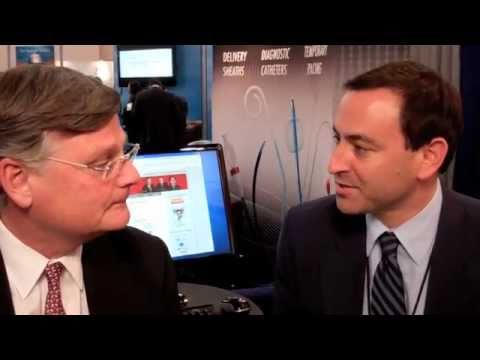Types of heart rhythm disorders
Atrial fibrillation (A-fib): Chaotic or abnormal conduction in the atria, resulting in poor and ineffective atrial contraction and an irregular beating of the ventricles. The atria quiver, decreasing the amount of blood ejected from the heart with each heartbeat. Atrial fibrillation may be episodic or continuous, and may or may not be recognized when it occurs. Symptoms depend on how fast the heart is beating and how much blood is being pumped to the rest of the body. This arrhythmia is not immediately life-threatening, but due to an increased risk of stroke (from clots that can form in the poorly contracting atria) swift and appropriate diagnosis and treatment is important. Long-term anticoagulation, with Coumadin®, is often indicated. This is considered a fast heartbeat arrhythmia.
Atrial flutter (A-flutter): An arrhythmia with many of the same characteristics as atrial fibrillation. With atrial flutter, the atria contract consistently at a very rapid rate and the ventricles may beat either in a regular or irregular rhythm. The approach to therapy is similar to that for atrial fibrillation.
Heart block (atrioventricular block or AV block): A malfunction or blockage in the conduction system between the atria and the ventricles. Conduction to the ventricles from the atria is slightly delayed (first-degree heart block), intermittently blocked (second-degree heart block), or completely blocked (third-degree heart block). Depending on the severity of the heart block, a pacemaker may be required. This is considered a slow heartbeat arrhythmia.
Paroxysmal supraventricular tachycardia (PSVT): These heartbeats are typically felt as very rapid heart palpitations or pounding in the chest and are seen with all age groups. Although medication may be helpful in the treatment of PSVT, catheter (radiofrequency) ablation may be indicated to eliminate the problem. This is considered a fast heartbeat arrhythmia.
Premature beats or contractions: A single, early beat that originates in the atria (called premature atrial contractions or PACs) or the ventricles (called premature ventricular contractions or PVCs). Often described as a “skipped” beat when they occur, they are frequently harmless and do not require treatment. When they occur very often or repetitively, they can lead to a more serious rhythm disturbance.
Sick sinus syndrome (SSS): A condition in which there is a malfunction of the sinoatrial node, the heart’s normal pacemaker. As a result, several abnormal rhythms can occur, both fast (tachycardias) and slow (bradycardias). This arrhythmia is most commonly seen in the elderly.
Sinus bradycardia: A sinus rhythm (regular rhythm) but with a resting heart rate that is less than 60 beats per minute. Sometimes this is a normal occurrence, especially in well-trained athletes or during sleep, or it can occur with certain medications (e.g., beta-blockers or digoxin). A medical evaluation is usually necessary if symptoms are experienced during the slow heart rate. This is considered a slow heartbeat arrhythmia.
Sinus tachycardia: A sinus rhythm (regular rhythm) but with a resting heart rate that is greater than 100 beats per minute. A resting heart rate that is greater than 100 is not normal and usually means there is an underlying problem that should be evaluated. This is considered a fast heartbeat arrhythmia.
Supraventricular tachycardia (SVT): A generic term that refers to any arrhythmia that begins above the ventricles in the atria. Examples of SVT are atrial fibrillation/atrial flutter and paroxysmal supraventricular tachycardia. These are considered fast heartbeat arrhythmias.
Ventricular tachycardia (V-tach or VT): A potentially life-threatening arrhythmia that originates in the ventricles or lower chambers of the heart. The heart rate may be 100 to 240 beats per minute. Depending on the duration and rate of the VT, the heart may be unable to pump adequate blood through the body. If the VT is going at a fast rate, it can cause a person to lose consciousness. Immediate defibrillation is required to get the heart back to its normal, slower rhythm. Ventricular tachycardia may also quickly turn into ventricular fibrillation and is treated by immediate defibrillation. This is considered a fast heartbeat arrhythmia.
Ventricular fibrillation (V-fib or VF): A life-threatening heart rhythm that originates in the ventricles or lower chambers of the heart. The ventricles “quiver” in a chaotic, purposeless fashion and are unable to pump adequate blood through the body. Collapse and sudden death follow quickly unless defibrillation is provided immediately. A person with this “sudden death” arrhythmia may be a candidate for an implantable cardioverter defibrillator. This is considered a fast heartbeat arrhythmia.






